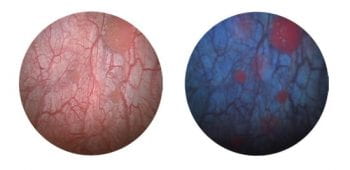Washington University urologists are working to detect bladder cancer and thus decrease recurrence using the diagnostic capabilities of an optical imaging technology called Blue Light Cystoscopy (BLC™) with Cysview®. With the improved cancer detection methods made possible by this technology, our urologic surgeons can make better management decisions for their patients.
Cystoscopy is a procedure that enables a urologist to have a detailed view of the bladder and urethra, and is used in patients with known or suspected bladder cancer. It traditionally employs white light technology to identify suspicious areas. Since bladder cancer is the fifth most common cancer for both men and women, with 81,000 cases and 17,000 deaths per year, better detection methods can mean improved patient care. About 50 to 80 percent of bladder cancer patients have recurrences, and limitations of traditional cancer detection methods mean some tumors may be missed. Blue Light Cystoscopy with Cysview® helps a physician assess general health of the bladder and find irregularities that need further evaluation, such as with biopsy.

Cysview® is an FDA-approved imaging drug that significantly increases detection of non-muscle invasive bladder cancer. Instilled in the bladder, the agent penetrates the cellular membrane of cancer cells. The blue fluorescence causes cancers cells to glow bright pink, making them more visible and potentially revealing additional tumors not visible under white light as they stand out against normal bladder tissue.
Phase III studies using BLC™ and Cysview® demonstrated statistically significant improvement in the detection of papillary tumors and carcinoma in-situ, as well as a significant reduction in recurrence rates.* Advantages also include fewer procedures and biopsies for patients because tumors are able to be detect and remove the tumors at one time.
*Stenzl A, Burger M, Fradet Y, Mynderse LA, Soloway MS, et al. Hexaminolevulinate guided fluorescence cystoscopy reduces recurrence in patients with nonmuscle-invasive bladder cancer. J Urol. 2010; 184(5): 1907-1913.
Grossman HB, Stenzl A, Fradet Y, Mynderse LA, Kriegmair M, et al. Long-term decrease in bladder cancer recurrence with hexaminolevulinate enabled fluorescence cystoscopy. J Urol. 2012; 188(1): 58-62.
Daneshmand S, Patel S, Lotan Y, et al. Efficacy and safety of blue light flexible cystoscopy with hexaminolevulinate in the surveillance of bladder cancer: A phase III, comparative, multicenter study. J Urol. 2018; 199(5): 1158-1165. doi: 10.1016/j. juro.2017.11.096. Epub 2017 Dec 2.
Daneshmand S, Bazargani ST, Bivalacqua TJ, Holzbeierlein JM, Willard B, et al. Blue light cystoscopy for the diagnosis of bladder cancer: Results from the US prospective multicenter registry. Urol Oncol. 2018. May 30. pii: S1078-1439(18)30135-2. doi: 10.1016/j.urolonc.2018.04.013. [Epub ahead of print]